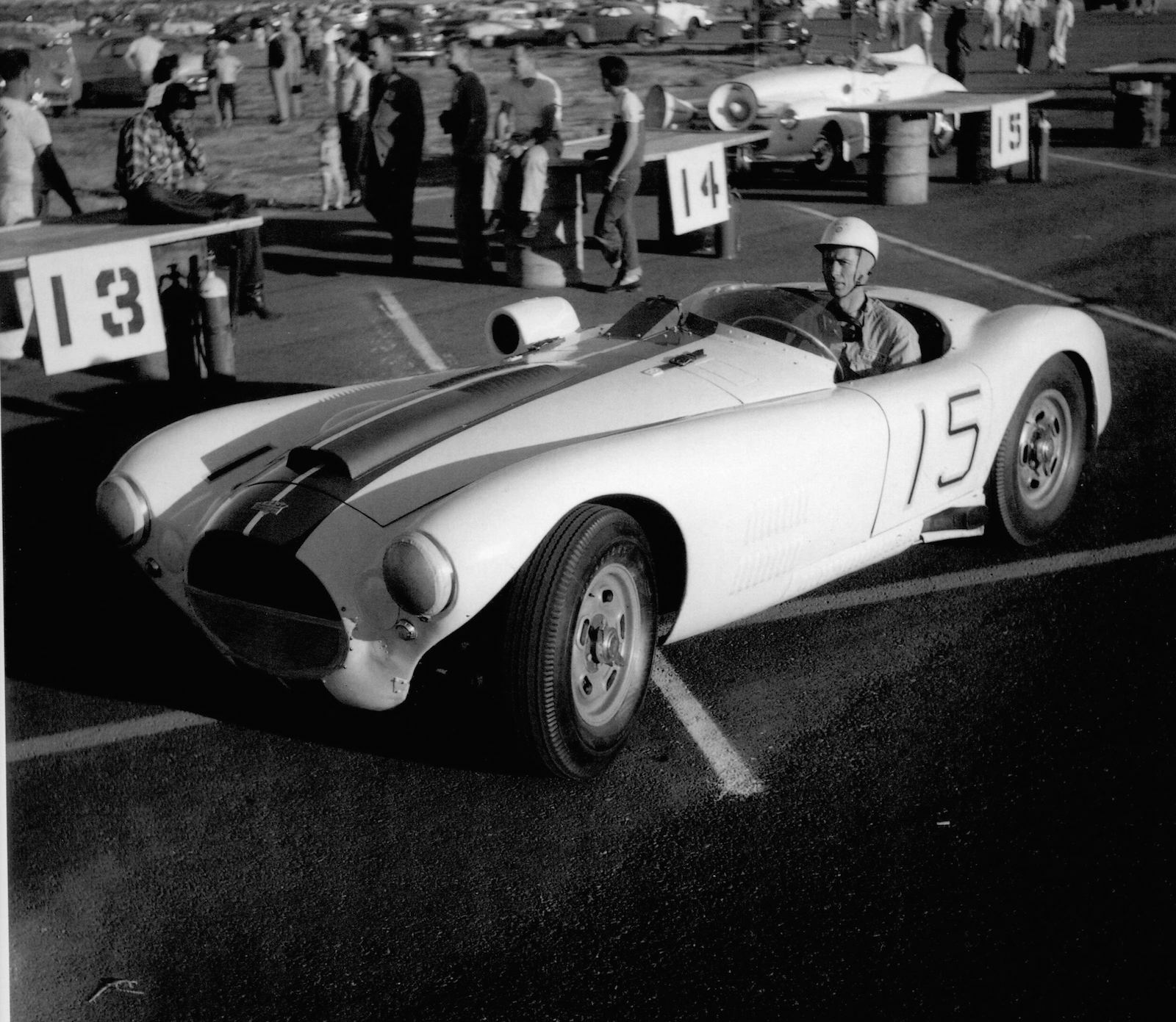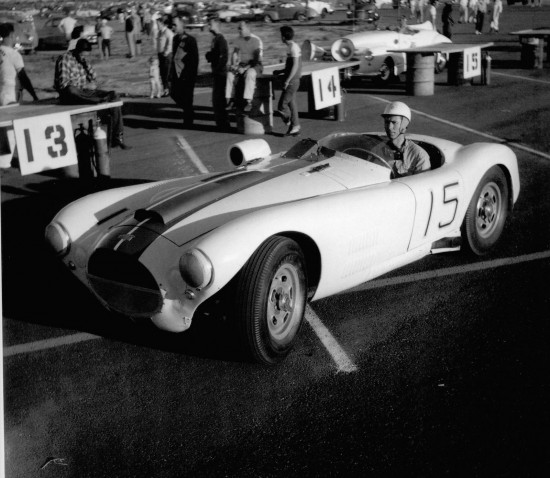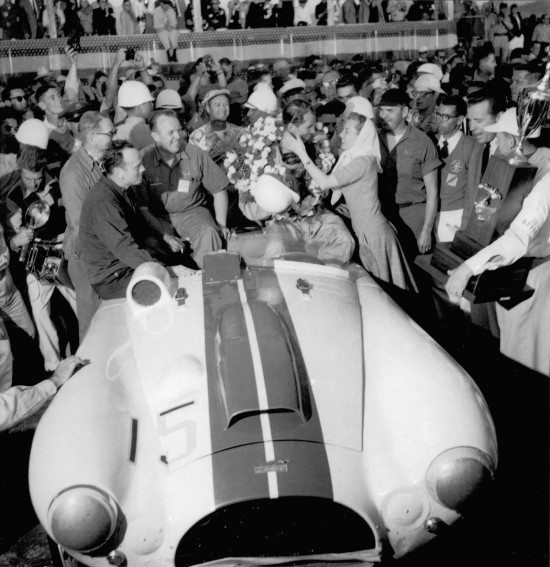by Mike –
I was scanning through the book, “American Sports Car Racing in the 1950s” by Michael T. Lynch, William Edgar and Ron Parravano, when I spotted these two photos of John Fitch in a Cunningham C-4 racecar.
These were taken at March Field in November 1953 by Dean Batchelor and are now part of the Ron Kellogg collection. Ron Kellogg was a friend of mine and he had a huge collection of original images from the old racing days, many of which have not been published.
In the photo below John Fitch is getting ready for a race that he won in the Cunningham C-4 – the first major postwar attempt to build an all-American car that could compete internationally.
In the photo below John Fitch is being congratulated by movie star June Allison while her movie star husband, Dick Powell, is standing next to the guy with the trophy.
Briggs Cunningham came in second also in one of his own C-4s.
Below is from the book, “March Air Force Base” by William J. Butler,
In 1952, Strategic Air Command (SAC) commander Gen. Curtis LeMay opened selected air bases throughout the United States to Sports Car Club of America (SCCA) organizations to hold races on base flight lines. LeMay was himself a sports car fan and drove a Cadillac-powered Allard in the early 1950s. Although wildly popular with race fans – tens of thousands of spectators turned out for races on any given weekend – the races cost the US government a great deal of money. The map of the March track reveals that designers used the long, smooth runway to good advantage in the track’s 3.5-mile length during races hosted in November 1953 and 1954. By 1955, the cash-conscious powers shut down the races for good. (Both images courtesy of the collection of Riverside International Automotive Museum).
It looks like the early 1950s were a lot of fun with car races and movie stars everywhere. And like today the guy who wins the race and the pretty lady are the star attractions.
Let us know what you think in the Comments.
This was first posted in December 2015.







Congratulations, by the beautiful text Mike !!
Interesting that the March field layout ran anti-clockwise like an oval track. Whereas Watkins glen or Brenfan tydden ran clockwise like a European track
Laguna Seca is also counter clockwise.
Is it clockwise or counter clockwise? The puffs of smoke associated with the cars seem to indicate it was a clockwise direction (but it is very difficult to see much clearly on the diagram).
In 1984 I rode my bicycle from just south of Seattle to Tijuana. In the week before I returned (by air) I happened to “stumble” across Brigg’s museum and had a chance to see that collection. He was there and fired up some old 19 tens or twenty car that sounded ancient and idled it around in the parking lot. I was saddened to read years later that the collection was sold and subsequently broken up. Those cars (and races) must have been brutal! My friend who lived in southern California at the time, racing these venues, told me that eventually weeds grew through the cracks in the tarmac and the ride could be so shaky that body panels would flex and vibrate and the racers worried more about their cars falling apart than the next guy ahead!
John Fitch was a genius inventor, with many patents, besides being an acclaimed international racecar driver. He invented the safety sand barrels we all see on the highways, in addition to many other safety devices for the road, after witnessing the carnage at the 1955 24 Hours at Le Mans. He lived not far from Greenwich, Connecticut, and would be at the Concours de Elegance every June, driving his Fitch Phoenix, the sports car that he designed and sold himself, after GM rejected his offer to sell them the rights to it. It was based on the Chevrolet Monza, but was heavily modified for competition engine-wise, suspension-wise, and body-wise. He just recently died, at age 99, and drove that Fitch Phoenix every year until he died. He sold quite a few of them as well. We shall not see the likes of his type again in the very near future. Besides all of that, he was a fighter pilot during WWII, and also sold customized Fitch Cougars (heavily modified Mercury Cougars) through his family’s store, Abercrombie and Fitch in the 1960’s.
Glenn in the Bronx, NY.
Fitch Phoenix was based more on a Corvair and I believe only one was completed
Yes, it was based on the Corvair you can see what are likely the last photos of John Fitch with the Fitch Phoenix at this link here on My Car Quest,
https://mycarquest.com/2011/03/john-fitch-a-great-racing-driver-and-much-more.html
In my original statement nearly 3 years ago, I meant to say the Chevrolet Corvair Monza. My mistake.
I productionized (i.e., corrected all the errors in Fitch’s mock-up) the Phoenix, contracted the build of the Phoenix with Fitch, then sub-contracted construction to Carrozzeria Intermeccanica, which in turn subcontracted build to a number of small shops in Torino. I made the deal with Fitch the third week of February, 1966, and the one and only Corvair-based Fitch Phoenix was on display at Abercrombie and Fitch in Manhattan on the 4th of July, 1966. I bought Frank Reisner’s own Corvair coupe to serve as the base for the four-month project. I think we charged Fitch $12,500, and both Reisner and I pocketed a few hundred dollars profit at the end of it all. And Frank got rid of the Corvair he didn’t like very much.
You could do astonishing things in Torino for peanuts in the Sixies, but it was hard to accumulate those little sums, which is why there were not more amusing cars like the Phoenix or the Mustang station wagon, also knocked out in short order for minimum expenditure in those days.
Robert Cumberford
Wonderful photograph. John Fitch was a wonderful gentilman and a great driver of that era. He was a good friend to my brother Ali during Ali’s illness. However in the photo there is a strange car behind the “pit wall” (if you could call it that) it seems to be an American convertible that had sheet metal congress with an F-86! What is the story behind the four wheel jet? Any “know it all” out there know the story behind is car? Enjoyed the story very much.
Thank you for bringing some precious history to light and preserving it. Well done.
John Fitch was one of the classiest guys I ever met in car circles, very modest considering his accomplishments. As I read military history I know he accomplished a lot during the war, such as this quote from Military.com
“John was a bomber pilot and P-51 Mustang pilot in WWII. He is one of the three American pilots to shoot down a German jet during the war. He said to me, “I cheated and shot him down when he was landing with no fuel!”.
John was actually a POW for a few years, escaped and ended up working with a special agency (had to be the OSS and you will not find it in his bio) towards the end of the war. He ended up sneaking behind enemy lines to steal German aircraft, pilot them back, and land them (“often we crashed landed”) so we could re-engineer the specs.”
In car safety, his barrels at “gore points” were a low cost life saver. I would say that when he got into auto safety he didn’t just talk like Nader but showed how to make things safer.